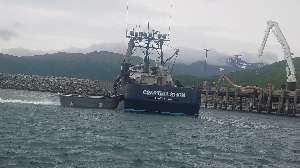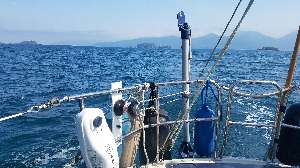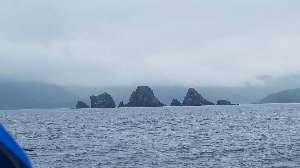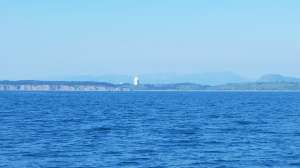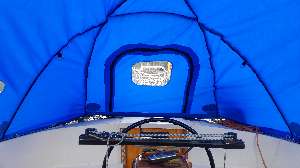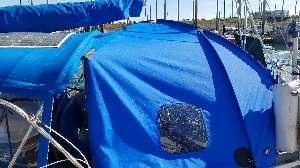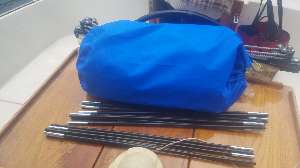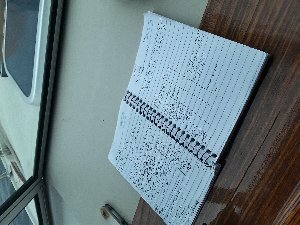The second boat asked how much fuel the first boat was taking on. The captain replied, ”I’m just topping off the two forward tanks. Two thousand gallons, maybe. ” They continued to politely negotiate while I turned my attention to other things.
Friday, today is Sunday, Jennifer and I left King Cove to start our tour of the south side of an island. The wind was to have been pleasant from the west at 10-15 knots outside, but inside between the islands we expected to motor. The wind, as it does here in Alaska started as a nice breeze coming down through a valley west of King Cove, then quieted to the point of considering motoring, then picked up as we passed a bay, building for the next few hours.
Caro Babbo easily sails faster than her theoretical hull speed. We were quickly sailing between 7.2 and 7.8 knots. Ahead, on AIS, we could see our French friends on Inook, a Boreal 46. To be as close behind them as we were, meant we were going faster than they were. This is always disconcerting.
There is the matter of pride that we should be able to overtake a vessel that large, and the uneasiness that we are.
As the wind built, we heeled past 25 degrees and it was time to reef.
The waves had built and as I stood on the deck I was splashed and eventually slipped and fell down. I finished most of the reefing kneeling, I put in a double reef. We did lose a bit of speed, settling in at 7 knots.
The wind clocked (rotated clockwise when looked at on a compass) to full north. Ninety degrees from where it should be. Our chosen anchorage, East Anchor Cove, would be untenable. But, hope springs eternal: I insisted we sail into the cove only to sail right back out again.
Jennifer considered the next two candidates, neither of which would work, and plotted a course three hours further to Dora Harbor inlet.
The wind faded when we were close into the lee of a cape. I wanted to get there now; it was a longer day than I had planned. We left all the sails up and motorsailed at 6 knots into the inlet.
Jennifer pointed out on the way down from East Anchor Cove that there was now an ocean swell from the south that flowed into our new harbor. Moving deeper into the harbor we became protected from the swell by a line of denticulate rocks the blocked about 10% of the mouth.
After studying the weather, Jennifer concluded we could not continue our planned voyage to Dutch Harbor; we’d need to back track three hours and then head north to False Pass and go to ‘Dutch’ via the Bering Sea.The weather on the way to False Pass would be unpleasant, without I thought she forecasted.
She didn’t mean to intimate that, but I slept poorly.
The anchorage was quiet with only the smallest surge coming in. The wind died overnight, as is common.
We left the anchorage with no sails set. When we hit the southerly swells I put up a double-reefed main to stop the rolling.
There was no appreciable wind the entire two hours to the pass.
We had weighed anchor at 5am to catch the northerly flood to take us to False Pass. We were later than we normally transit such things, but all went smoothly with the expected sharp currents and eddys that divert and spin us. The Raymarine autopilot was quite good at keeping us pointed in the right direction. Where we were actually going, versus pointing was something Jennifer kept a hand on.
Our time in False Pass has been full. It is the busiest commercial harbor we have been in with vessels off loading fish 24-hours a day.
In the yard are easily a hundred refrigerated containers: this is how much fish they process here. The midsize tenders collect about 260,000 pounds of fish from the fishing boats. The largest tenders collect over 600,000 pounds.
(Please forgive this writing. A phone cramps my abilities.)
Because pleasure boats are so rare, everyone speaks with us. People fishing are the nicest people, but I’ve written about this before.
About a mile from the harbor is an old fishing camp, the locals call it, but it was the other dorms and docks for Peter Pan, one of the current large fish processors. It is very apparent that the intended to return the next season and did not.
Everything is intact as is the people just walked out the door.
The dates are confusing. Calendars in the rooms are as late as 2019. A local man who grew up here tells us that the precessing building burnt down in 1982, and that the camp had not be in use since the nineties.
What excites Jennifer and me is the we have seen the remains of similar communities with only pilings remaining. Here all the boardwalks, buildings and docks are still there.
On our way to revisit the site, Cindy who works for Trident intercepted us to ask where we were from and other things, and then warned us about the brown bears that have been wandering about the site. We’d seen scat, but didn’t think it was from brown bears. Turns out it is a mother and two two-year olds.
We took bear spray with us.



